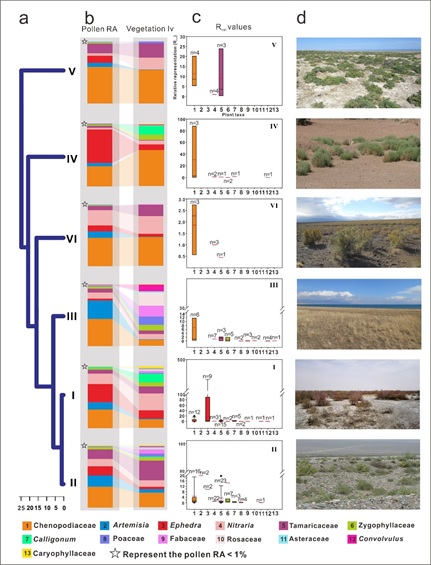Reconstructing the past vegetation and climate changes based on fossil pollen data is an indispensable and key component of global change research. However, there is always a notable deviation on the relative abundance values between the surface and fossil pollen assemblage and corresponding modern vegetation. This phenomenon is usually caused by differences in pollen production, dispersal mode and preservation capacity in the soil. Therefore, the concept of representation (R) value was introduced as a correction coefficient to counterbalance this deviation. Regretfully, few pollen R-values studies have addressed in specific ecosystem.
Recently, researchers from the Institute of Botany of the Chinese Academy of Sciences made new progress on quantitative relationship between pollen and vegetation in the arid central Asia (ACA). They proposed a new scheme of  median values from modern desert vegetation types in the eastern ACA. The study published online in Palaeogeography, Palaeoclimatology, Palaeoecology.
median values from modern desert vegetation types in the eastern ACA. The study published online in Palaeogeography, Palaeoclimatology, Palaeoecology.
The researchers calculated R and  adjustment coefficient of the dominant taxa using surface pollen and related modern vegetation data from 145 sample plots along an east-west desert transect. The results showed that taking Nitraria as a reference, Chenopodiaceae, Artemisia and Ephedra are highly represented, while Tamaricaceae, Zygophyllaceae, Asteraceae (excluding Artemisia), Calligonum and Poaceae are poorly represented.
adjustment coefficient of the dominant taxa using surface pollen and related modern vegetation data from 145 sample plots along an east-west desert transect. The results showed that taking Nitraria as a reference, Chenopodiaceae, Artemisia and Ephedra are highly represented, while Tamaricaceae, Zygophyllaceae, Asteraceae (excluding Artemisia), Calligonum and Poaceae are poorly represented.
They further found that the pollen representation was constrained by their pollination strategies. For example, anemophilous plants (e.g., Ephedra, Artemisia and Chenopodiaceae) are mostly over-represented, while those of entomophilous taxa (e.g., Nitraria, Tamaricaceae, Zygophyllaceae and Calligonum) are under-represented.
This study provides a new way on quantitatively reconstructing the past desert vegetation succession in the ACA, and not only helpful for understanding the evolution of temperate desert ecosystems, but also provides an example for the quantitative reconstruction of deep-time vegetation in other ecosystems.

Cluster analysis based on surface pollen assemblages of six desert vegetation types
Article Link: https://doi.org/10.1016/j.palaeo.2022.110993
Contact:
WANG Yufei and YAO Yifeng
wangyf@ibcas.ac.cn; yaoyf@ibcas.ac.cn
Institute of Botany, Institute of Botany, the Chinese Academy of Sciences
Reconstructing the past vegetation and climate changes based on fossil pollen data is an indispensable and key component of global change research. However, there is always a notable deviation on the relative abundance values between the surface and fossil pollen assemblage and corresponding modern vegetation. This phenomenon is usually caused by differences in pollen production, dispersal mode and preservation capacity in the soil. Therefore, the concept of representation (R) value was introduced as a correction coefficient to counterbalance this deviation. Regretfully, few pollen R-values studies have addressed in specific ecosystem.
Recently, researchers from the Institute of Botany of the Chinese Academy of Sciences made new progress on quantitative relationship between pollen and vegetation in the arid central Asia (ACA). They proposed a new scheme of ![]() median values from modern desert vegetation types in the eastern ACA. The study published online in Palaeogeography, Palaeoclimatology, Palaeoecology.
median values from modern desert vegetation types in the eastern ACA. The study published online in Palaeogeography, Palaeoclimatology, Palaeoecology.
The researchers calculated R and ![]() adjustment coefficient of the dominant taxa using surface pollen and related modern vegetation data from 145 sample plots along an east-west desert transect. The results showed that taking Nitraria as a reference, Chenopodiaceae, Artemisia and Ephedra are highly represented, while Tamaricaceae, Zygophyllaceae, Asteraceae (excluding Artemisia), Calligonum and Poaceae are poorly represented.
adjustment coefficient of the dominant taxa using surface pollen and related modern vegetation data from 145 sample plots along an east-west desert transect. The results showed that taking Nitraria as a reference, Chenopodiaceae, Artemisia and Ephedra are highly represented, while Tamaricaceae, Zygophyllaceae, Asteraceae (excluding Artemisia), Calligonum and Poaceae are poorly represented.
They further found that the pollen representation was constrained by their pollination strategies. For example, anemophilous plants (e.g., Ephedra, Artemisia and Chenopodiaceae) are mostly over-represented, while those of entomophilous taxa (e.g., Nitraria, Tamaricaceae, Zygophyllaceae and Calligonum) are under-represented.
This study provides a new way on quantitatively reconstructing the past desert vegetation succession in the ACA, and not only helpful for understanding the evolution of temperate desert ecosystems, but also provides an example for the quantitative reconstruction of deep-time vegetation in other ecosystems.

Cluster analysis based on surface pollen assemblages of six desert vegetation types
Article Link: https://doi.org/10.1016/j.palaeo.2022.110993
Contact:
WANG Yufei and YAO Yifeng
wangyf@ibcas.ac.cn; yaoyf@ibcas.ac.cn
Institute of Botany, Institute of Botany, the Chinese Academy of Sciences
